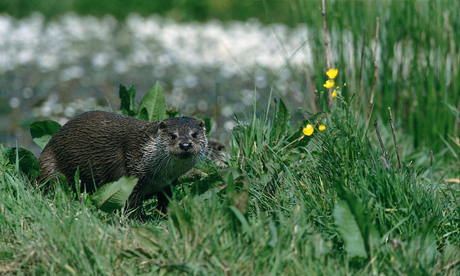Otters in the Lea Valley: just another anglers’ tale?

Going swimmingly: Otter numbers are increasing in Britain. Photograph: Lee Valley Regional Park Authority
All along the Lea Valley are informational boards advertising the presence of large aquatic predators wont to send nature lovers all aquiver with excitement – otters.
Could these mysterious creatures really exist in built-up areas like Hackney?
Yes, according to experts, but you have about as much chance of seeing one as you do of seeing the Loch Ness Monster.
The valley that holds the River Lea extends from the Thames Docklands through Hackney and up to Hertfordshire past Ware and includes many large reservoirs and ponds.
Numerous rare species can be found there including the bittern, a wading bird that hides among reeds, and the health of the once despoiled Lea is said to be improving.
Spraint, the excreta otters use to mark their territory, has been found in Walthamstow Marshes, and seven years ago an otter was found dead in Tower Hamlets after being hit by a car.
“We know otters are in the upper Lea Valley and anecdotal evidence suggests their numbers are increasing,” says Cath Patrick, a senior conservation officer for the Lee Valley Regional Park Authority.
“Male otters can have a territory of as much as 26 miles, so there is a possibility they could start coming down and using the part of the Lea that runs through the Olympic Park. An artificial otter holt was set up there and the reed beds are ideal for otters.
“There is even scope they could enter the Thames and move into south London.”
The animals, which are related to stoats, weasels and badgers and were romanticised in books like Ring of Bright Water and Tarka the Otter, are making a comeback in several parts of Britain since being hunted to near extinction for their pelts.
They are also vulnerable to pollution, can become entangled and die in fishing nets and are frequently casualties on our roads.
Otters voraciously hunt fish and stories about them decimating expensively stocked ornamental carp ponds or harming livelihoods by depleting fish farms have done nothing to help their reputation.
Ms Patrick has an old newspaper cutting containing a photograph of Archie Miller, reputed to be England’s champion otter-catcher, who killed at least 87 otters in the Lea Valley area.
A macabre man who used a coffin for a bed, Mr Miller died in 1959 after carrying out his programme of extermination, which was intended to protect a local commercial fishery.
As well as fish, otters like to eat water voles, which can be found around Walthamstow and Hackney Marshes and which are also preyed upon by American mink – an invasive species that escaped from commercial fur farms in the 1950s.
Three otters from captivity were controversially reintroduced into the upper Lea Valley in the early 1990s and Ms Patrick says these individuals went on to successfully breed and rear young.
The Lea Valley Regional Park Authority relies on sightings from members of the public but also carries out surveys involving looking for otter spraint, which Ms Patrick describes as “not unpleasant at all”.
The aroma is described as “like sweet jasmine tea”.
In her book Otter Country: In Search of the Wild Otter, poet Miriam Darlington writes: “Otters are the only animal I have come across whose excretions smell like perfume.”
For the best chance of seeing an otter in the Lea Valley, experts advise waiting by the water at dawn or dusk and remaining still and quiet as otters are notoriously shy.
They are, however, quick to point out that you could be waiting a long time as there could currently be as few as just four or five individuals in the entire 26 miles covered by the valley.
